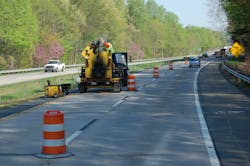WASHINGTON, DC. With Federal fuel tax revenues unable to meet current and future infrastructure needs, the next highway bill could “replace the fee at the pump completely … and replace it with a sales tax on fuels,” according to Sen. Barbara Boxer (D-CA), chair of the Senate committee responsible for crafting that bill. Acknowledging that “the funding source is the main sticky wicket” in passing a bill to reauthorize highway and infrastructure spending, Boxer told an audience representing various highway users that “we can’t have a great country without a great infrastructure.”
The Highway Trust Fund used to pay for Federal spending on infrastructure maintenance and construction relies solely on diesel and gasoline fuel taxes, with recent shortfalls in spending needs supplemented by repeated Congressional authorizations from the general tax funds. “We can’t push this funding question down the road,” Boxer said. The fuel tax “hasn’t been raised in a long time,” but raising it “is very controversial and whether we can do it or not, I can’t say. But I’ve been looking for other ways to fund the trust fund.”
Boxer was speaking at the Infrastructure for the Future Summit, a one-day meeting of highway advocates sponsored by the American Highway Users Alliance and the Volvo Group. The American Trucking Assns.(ATA), the American Assn. of State Highway and Transportation Officials (AASHTO), the National Assn. of Manufacturers (NAM), and UPS were also cited as sponsors for the meeting.
The current highway bill, known by the acronym MAP-21, expires at the end of 2014. Without a new reauthorization bill, Federal infrastructure investment falls to zero in 2015, at least theoretically. In the past, Congress has been unable to craft an acceptable bill on schedule and has instead relied on repeated extensions to cover funding while it worked out the next reauthorization. This time some members of Congress are suggesting that Federal funding of infrastructure be “devolved” by allowing the authorization bill to expire without any extensions or reauthorizations, instead allowing the states and private sources to provide the investments.
Accusing “infrastructure deniers” of playing “political rope-a-dope … where the public official is absolutely positively in favor of roads, bridges and mobility, but just can’t be for any proposal that might make getting reelected difficult,” ATA president Bill Graves predicted that “the change in political will, the financial support we seek for infrastructure will eventually happen.”
The country’s economy and growth, coupled with “the insatiable appetite of Americans for their mobility” will drive that change, he said. “When it does, Americans will have to pay a little more in some form or fashion, but there is simply no solution to this challenge that will be free.”
While a menu of funding sources will eventually be needed, the near-term solution is to raise Federal fuel taxes indexed to price, according to Graves. “And by now I’m convinced that everyone on Capitol Hill knows it. They’re just praying that if they deny it long enough, it will somehow go away. … devolving to the states isn’t the answer.”
As chair of the House Transportation and Infrastructure Committee, Rep. Bill Shuster (R-PA) said he was committed to developing a bipartisan highway bill that would make it easier for states and others to access Federal funding for projects while also promoting emerging technologies to improve the safety and efficiency of the transportation network. He also said freight mobility would be central to any bill coming out of his committee.
Unlike his Senate counterpart, Shuster avoided specific funding proposals. “When it comes to funding, we have to consider everything, but we shouldn’t lead with funding.” Instead, he told the summit, “it’s important to build a case, to make sure the American people understand the problem first, and then the funding will be a byproduct of that.”
Putting aside questions of funding sources, any infrastructure investment should be complimented by new technologies to improve utilization and efficiency, according to Volvo Group president and CEO Olof Persson. He told the group that the technology already exists for moving more freight and people more efficiently to maximize the impact of infrastructure investments and create a more sustainable transportation system.
“We have never in history had such intelligent vehicles as we have on the roads today, but they are operating on a infrastructure that looks pretty much the same as it did back in 1885,” Persson said. Connecting trucks and cars to the infrastructure, as well as to one another, “is a great opportunity to enhance and make transport more efficient.”
Automated vehicle operations is another emerging technology with implications for infrastructure efficiency, he said, pointing out that current systems like lane departure warning and automated braking are leading an evolution from driver assistance to full automation. Persson outlined Volvo’s participation in the European SARTRE program, which uses a professional truck driver to lead a platoon of trailing automobiles, as one example of how automation might increase highway capacity without endangering safety.
As an aside, Persson said Volvo would join with the Univ. of California to run a similar demonstration of platooning on California’s I-5 in 2016.
Increasing truck size and weight limits would also contribute to better utilization of highways, Persson said, pointing out that existing and emerging advanced safety technology makes that option practical.
Returning to the issue of paying for future infrastructure projects, Rep. John Delaney (D-MD) outlined a bill he’s introduced to create a $50 billion fund. If enacted, Delaney’s Partnership to Build America Act would establish the American Infrastructure Fund to make loans and loan guarantees to states and local governments for projects. Capital for the $50 billion fund would come from low-interest bonds sold as a mechanism for U.S. companies to bring back overseas earnings.
More Fleet Owner videos from the Infrastructure for the Future Summit on funding proposals and greater vehicle efficiency.
About the Author
Jim Mele
Jim Mele is a former longtime editor-in-chief of FleetOwner. He joined the magazine in 1986 and served as chief editor from 1999 to 2017.
